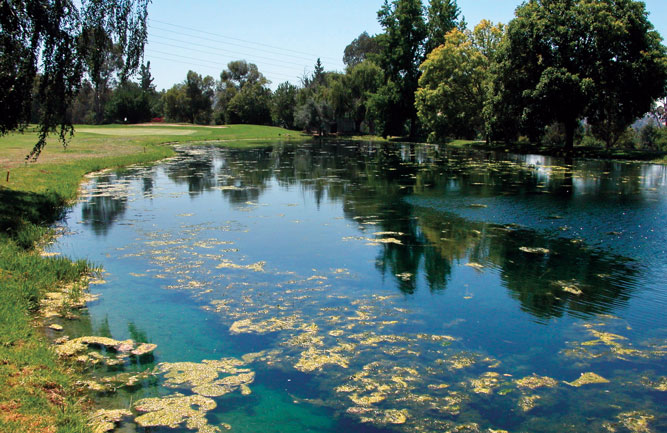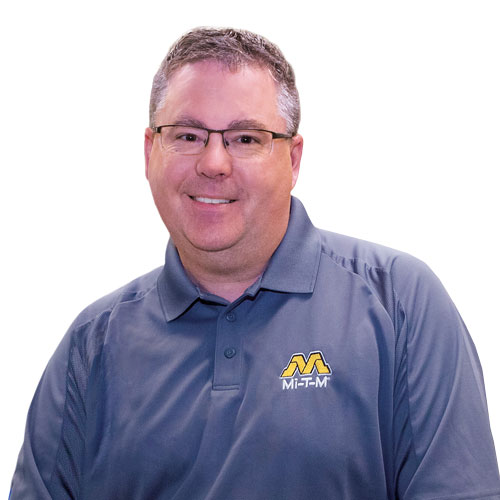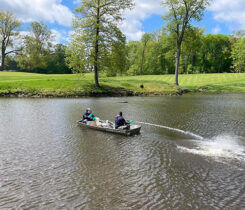Industry experts share the inside scoop on water feature maintenance
As superintendents strive to maintain their courses’ water features, they’ll typically encounter two common pitfalls; unwanted aquatic plants and algae growth. According to Byran Fuhrmann, Ph.D., aquatic technology development scientist at SePRO Corp., excessive phosphorus is often the main culprit.

Feed carefully. Experts say superintendents should avoid applying fertilizer on turf near ponds and lakes to avoid algae buildup. (Photo: Ewing Irrigation & Landscape Supply)
“Many aquatic plants have roots that can penetrate deep into the sediment, so it’s usually infeasible to thwart their ability to access a large pool of sediment phosphorus,” Fuhrmann stresses. “Therefore, aquatic herbicides are generally the best strategies to prevent or manage unnecessary aquatic plants.”
In his opinion, systemic herbicides are the best options, as they offer superintendents long-term control. Additionally, superintendents can utilize them proactively throughout the winter to prevent undesirable aquatic plant growth the rest of the year.
On the flip side, most algae rely on water column phosphorus or phosphorus located at the sediment’s surface, which is ultimately a smaller pool. Consequently, superintendents often find that, by managing phosphorus with binding agents, they have a practical, cost-effective technique as they strive to prevent excessive algae growth.
“It’s also an incredibly efficient method to improve aesthetics, as just 1 pound of phosphorus can grow more than 500 pounds of algae,” he says. “In turn, 500 pounds of algae is enough to change the color of 4 acre-feet of water from blue to lime green and even give 10 acre-feet of water a slightly green color.”
He continues, “In general, the removal of 1 pound of phosphorus only costs a few hundred dollars. This can be the key difference between a superintendent having a beautiful, blue pond and an ugly, green swamp.”
It’s also important to remember that algaecides will often release phosphorus into lakes or ponds, leading to new algae growth after the algaecides dissipate a few weeks later.
“With this in mind, superintendents can follow up an algaecide treatment with a phosphorus binding agent, which will help limit future algae growth,” he adds.

Pat Gross (Photo: Ewing Irrigation & Landscape Supply)
Ewing Irrigation & Landscape Supply
Pat Gross
Inside sales
As superintendents strive to manage lakes on their courses, they will encounter one key issue: algae. To avoid algae infestations, superintendents must be very careful when fertilizing next to lakes and water features to ensure that no fertilizer is applied directly or indirectly to the water. Fertilizer runoff into the water will provide nutrients for algae and aquatic weeds. In fact, only 5 parts per million of phosphorus can cause an algae bloom — an incredibly small amount. Superintendents must consider providing good circulation. In doing so, they’ll maintain adequate oxygen content in their courses’ water features. In addition, good circulation will help break up algae mats and feed beneficial microorganisms in the water.

Demi Fortuna (Photo: Atlantic-OASE)
Atlantic-OASE
Demi Fortuna
Director of product information
The primary issue in maintaining the appearance and quality of water on the golf course is algae control. Chemical algae control may be environmentally or economically prohibitive, and physical removal is impossible. The best — and most cost-effective — way to control algae is to limit sunlight and remove nutrients. Bacteria consume nutrients to starve out algae; apply by simply tossing in tablets or blocks monthly. Subsurface aeration inexpensively and unobtrusively circulates the bacteria throughout even the largest water features, while surface aeration fountains are attractive but not as effective for circulation. Finally, pond dye tints the water and blocks the sunlight that algae and other submerged weeds need to grow. Together, this three-pronged approach ensures that water features look their best.

Lawrence Field (Photo: WaterIQ Technologies)
WaterIQ Technologies
Lawrence Field
CEO
To address their water bodies, I advise superintendents to have a preventative strategy versus a reactive, firefighting approach. The offseason is an excellent time for superintendents to address water features, especially before algae and toxic blue-green algae become major issues as temperatures rise. Superintendents should seek proactive strategies, along with the latest technologies, to ensure their courses’ water features remain stable, eye-pleasing and odor free, while also eliminating harmful blue-green algae — which can be toxic — and nuisance green algae. They can use a solution that hinders algae growth as long as they install it early. It also allows them to focus on their golf courses rather than overgrown algae issues. Consequently, they’ll be better stewards of the environment and their communities.

Aaron Auger (Photo: Mi-T-M Corporation)
Mi-T-M Corporation
Aaron Auger
Water treatment division manager
Superintendents should have a maintenance agreement with a local distributor for service to ensure their biological wash water treatment system runs as it should. Distributors’ networks will train agronomy staff members on how to properly use their reclaim systems. And they’ll help ensure that staff members conduct everyday tasks — such as the inoculation of microbes — and yearly tasks — like system draining and cleaning — on time. Local distributors are also promptly available for service calls whenever necessary, particularly if problems arise. Without question, superintendents will eventually have to service any piece of equipment. However, by having a reliable resource who can help with that task, superintendents can focus on their other daily
duties instead.












